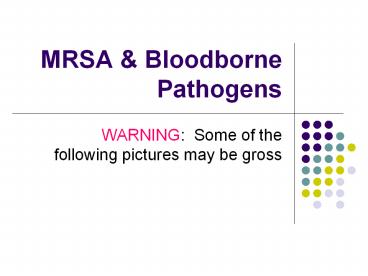MRSA - PowerPoint PPT Presentation
Title:
MRSA
Description:
MRSA & Bloodborne Pathogens WARNING: Some of the following pictures may be gross Objectives Define MRSA, Staph, bloodborne pathogens, and universal precautions ... – PowerPoint PPT presentation
Number of Views:145
Avg rating:3.0/5.0
Title: MRSA
1
MRSA Bloodborne Pathogens
- WARNING Some of the following pictures may be
gross
2
Objectives
- Define MRSA, Staph, bloodborne pathogens, and
universal precautions - Recognize symptoms of MRSA and how it is spread
- List 2 bloodborne pathogens and their symptoms
3
MRSAMethicillin-Resistant Staphylococcus Aureas
- What is it?
- Staph bacteria that live on the skin in the
nose - Usually harmless
- Estimated though that staph fatalities may exceed
AIDS deaths - MRSA type of staph
- Resistant to several types of antibiotics
4
MRSA
- Who gets it?
- Anyone
- Most often in hospitals healthcare facilities
- Athletes or other individuals in high contact
activities
5
MRSA
- How is it spread?
- Touching the infected skin/wound
- Sharing objects such as towels or athletic
equipment - Typically through physical contact (not air)
6
What does MRSA look like?
- Mainly on skin, in the nose, in wounds, or in
urine blood - Around open wounds or other openings where
bacteria can get inside the body - Common skin conditions caused by MRSA
- Infected cuts
- Boils
- Infected hair follicles
- Fluid filled blisters (impetigo)
- Skin sores that look like insect bites
7
(No Transcript)
8
MRSA
- Can spread to surrounding tissue
- Leads to abscesses or infections of the
- Blood
- Bone
- Heart infections
- Treatment?
- Some antibiotics are successful
9
Once MRSA is gone
- Bacteria may still live in your nose
- Wash hands often
- Sneeze or cough into tissue
- If new infection occurs, cover see MD
10
Prevention?
- Wash hands often!!
- If skin infection occurs, keep area clean
covered - Change bandage often especially if wet
- Prevent wound drainage from coming in contact
with anyone else - Avoid public spas, saunas, pools, manicures,
gyms, etc
11
Bloodborne Pathogens
- Pathogenic microorganisms that can potentially
cause disease - Universal Precautions
- Assume all fluid is contaminated fluid
- Cover open skin wounds
- Remove bleeding athletes from play
- Possible uniform change
- Protective equipment
- Gloves, gowns, masks, eye shield, CPR masks
12
(No Transcript)
13
Hepatitis B
- Major cause of viral infection affecting liver
functions - Dramatic increase in last 10 years
- Stronger, more durable than HIV
- Signs/Symptoms
- Flulike, jaundice, not present
- Transmission
- Direct indirect (surfaces 1 week) contact
14
Hepatitis B
- Infectious Material
- Blood, saliva, semen, feces, food, water
- Prevention
- Good hygiene, avoid high risk behaviors, vaccine
- Recovery
- Usually within 6-8 weeks
15
Human Immunodeficiency Virus (HIV)
- Viral infection that attacks healthy cells
- Estimated 40 million by 2000
- Signs/Symptoms
- Fever, night sweats, weight loss, diarrhea,
severe fatigue, swollen lymph nodes, lesions,
none (8-10 years) - Transmission
- Direct indirect contact
16
HIV
- Infectious materials
- Blood, semen, vaginal fluid
- Management
- cocktails
- Prevention
- Education
- Little risk to athletes, but possible































